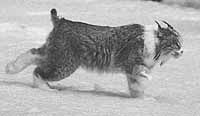| The Manti LaSal National Forest Service has confirmed that the Canada lynx species is currently living in the Joes Valley area. This is the first confirmed lynx to appear in the state since 1991. Further studies will be conducted to determine what conditions are needed to allow the lynx to survive in the area. It is unknown as to how the species entered the area. |
The Manti LaSal National Forest Service recently confirmed that hair samples from Canada lynx were found in the Joes Valley area.
Lynx are listed as threatened by the United States Fish and Wildlife Service and this case is the first confirmed lynx in Utah since 1991.
Attractants such as scents and visuals, were used to collect samples from lynx already in the area. Similar to a house cat, lynx and other animals will rub against things to leave scent. Hairs that stick to the barbed nails and carpet containing the attractant are sent to a lab to determine what animal they belong to.
The forest service checked the area and procedures to see if there was any possibility that the sample site was tampered with.
“In the western United States, lynx generally live in evergreen forests,” explained Rod Player, ecosystem group leader. “The hair sample was collected in an isolated location in good lynx habitat and there is no indication that this is anything except a real lynx sample. We are checking other possibilities, however, to see if an escapee from a fur farm, someone’s pet, or a transplanted lynx from Colorado found its way to the Joes Valley area.”
The forest service will work with the U.S. Fish and Wildlife Service to ensure that ongoing activities are compatible with the needs of the lynx. The main considerations include management of vegetation, expansion of winter recreation, and trapping.
“We are excited about welcoming the lynx back to the state. Our goal is delisting the species and seeing it back in its place in the forest,” stated Player.
For more information, contact Elaine Zieroth or Rod Player at 435-637-2817.

